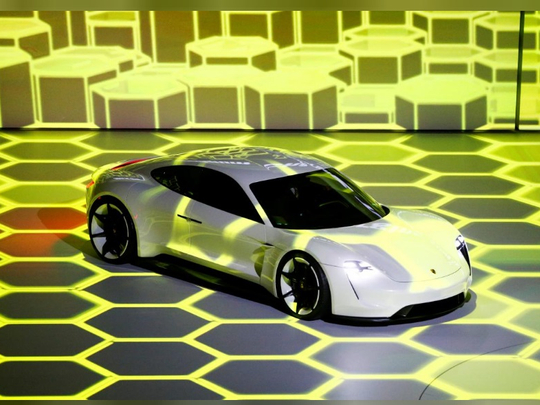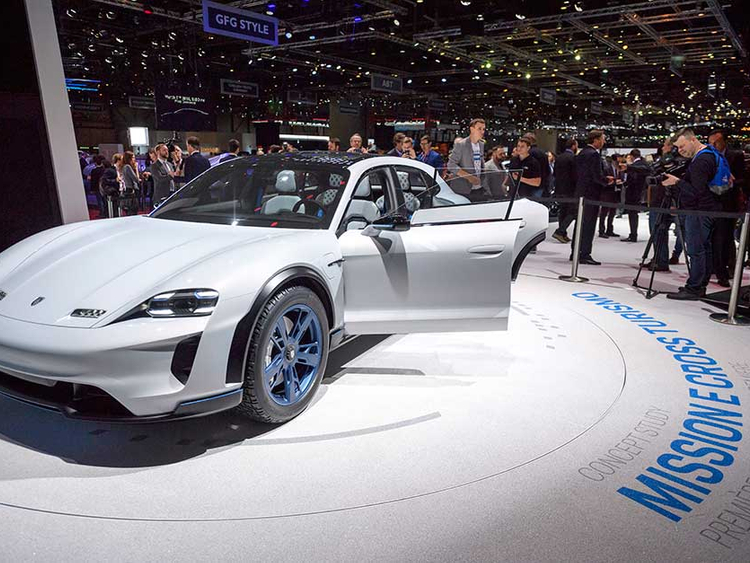
For the first time, German sports carmaker Porssche has released the first official images of its all-electric Mession E prototype, giving potential buyers a glimpse of the outlines, edges and even the "frunk" (front trunk).
Porsche says the first units will roll off their factories in 2019, but Mission E is already a winner: The concept won several design awards and had earned plaudits for its looks.
Now, EV junkies hope that the look and most features end up in the production version.
The Mission E prototype was originally unveiled in 2015. But other camouflaged prototypes have been spotted, according to EV magazine Electrek.
The first images of the latest Mission E prototype gives a good look at the front trunk. It appears to be a "usable size", though it's not clear how it compares with that of the Tesla Model S.
In its latest Annual and Sustainability Report published this week, Porsche discussed how it would the Mission E to production as the German automaker’s first all-electric vehicle.
“In 2019, the first purely electric Porsche will come onto the roads. Clear, puristic, with pioneering, practical Porsche e -performance. The Mission E is a true Porsche: output of over 600 hp, zero to 100 km/h in less than 3.5 seconds, and a range of 500 kilometres. Its charging time: 15 minutes for 80 per cent electrical charge.”
Alongside the report, the automaker released a few pictures of their latest prototypes.
More variants announced
Earlier this month, Porsche said it plans to build more variants of its first fully electric sports car, including one based on the Mission E Cross Turismo design, as the Volkswagen AG luxury brand readies for a seismic industry shift to battery-powered models.
Purely electric and hybrid vehicles will account for about a quarter of the division’s global deliveries in 2025, the German manufacturer said Friday at a press briefing.
Porsche is set to begin selling the battery-only Mission E sports car in 2019, and it presented the four-door Cross Turismo concept version at the Geneva car show in early March.
“For the next 10 years, Porsche is banking on three pillars: optimised combustion-engine cars, plug-in hybrid models and purely electric-powered sport cars,” Chief Executive Officer Oliver Blume said in a speech at the Porsche museum near the company’s Stuttgart headquarters.
“The world’s regions are developing differently. Therefore we’re preparing to be as flexible as possible.”
Audi cooperation
Safeguarding Porsche’s profits is vital for Volkswagen because Audi, the division that’s the group’s largest earnings contributor, is wrestling with the fallout from the diesel-emissions scandal that erupted in 2015.
That unit has lost ground in both sales volume and profitability to rivals Mercedes-Benz and BMW AG. Porsche and Audi plan to deepen cooperation to reap development-cost savings in the three-digit million-euro range.
Strict spending discipline is needed to offset the “enormous investments” in new technology, Chief Financial Officer Lutz Meschke told reporters. Porsche has doubled its electric-car development budget to 6 billion euros ($7.4 billion) by 2022.
246,000 Porsches sold in 2017
Porsche’s global deliveries reached a fresh annual record in 2017, rising almost 4 per cent to 246,000 cars.
Rapid volume growth in recent years has been largely driven by adding the compact Macan sport-utility vehicle to the line-up.
Porsche said it aims for “stable” deliveries and revenue this year.
Still, the introduction of a revamped version of the Cayenne SUV in China and the US, Porsche’s two largest markets, is set to bolster sales.
Demand for Porsche’s hybrid-car offerings is also promising, with some 60 per cent of buyers of the updated Panamera four-door coupe in Europe opting for the electric-gasoline version.
The technology for the next generation of Porsche’s iconic 911 sports car will also allow integration of a battery that could provide extra boost.
Porsche has led the way in high-end hybrid vehicles, and customers have warmly received the German carmaker's foray into electric drivetrains.
Battery supplies
In December, it was reported that battery suppliers are struggling to cope with buoyant demand for Porsche’s Panamera hybrid sedans, in a sign parent Volkswagen’s shift to cleaner vehicles may be paying off, but also of the challenges involved.
The share of Panamera hybrids, which combine a conventional combustion engine with electric propulsion, of the model’s total output has doubled in the past 12 months, Gerd Rupp, head of Porsche’s Leipzig plant, told Reuters in December.
The four-door Panamera hybrids are assembled in Leipzig.
“At present we are able to meet customer demand well,” he said in an interview, adding about 8,000 Panamera hybrids would be built this year. “But there are limits because we are dependent on the capacities of battery suppliers.”
“As a buyer we had originally projected different volumes (of battery systems needed),” Rupp said. “The effects can be seen in longer delivery times of currently 3-4 months for Panamera hybrid models.”
Following its diesel emissions scandal in 2015, Volkswagen announced a huge investment in electric and self-driving vehicles, gambling that demand was finally about to take off.
The success of the strategy has become all the more important, with new European regulations set to penalize carmakers that do not curb their CO2 emissions.














